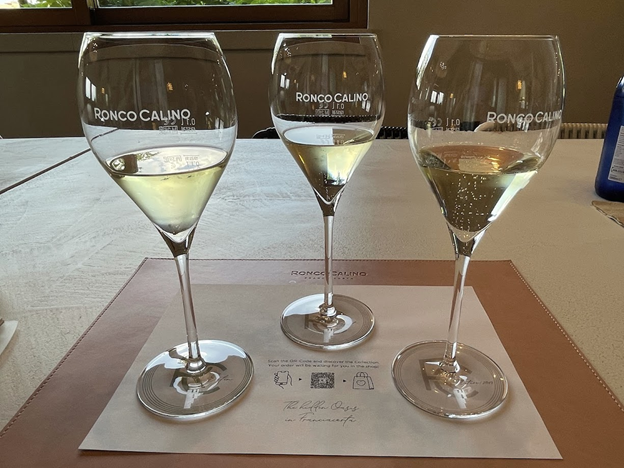New on the Horizon: Here Comes Unfizzy Vinho Verde
- Marla
- May 15, 2024
- 4 min read

If you’re familiar with Portugal’s Vinho Verde (literally, “green wine”) then you probably know it as that inexpensive, refreshing, slightly fizzy drink that comes from the Vinho Verde region in the Northwest of the country. It’s not as well known as wines from regions in other countries, such as Bordeaux or Tuscany, although it can be found in some retail shops and on a few restaurant wine lists.
But it turns out that Vinho Verde is actually a diverse wine region, not just a type of wine. And Portugal wants people to know that.
So the Vinho Verdes Region Viticulture Commission launched a comprehensive program this spring to introduce the wine trade and media to some of the other, premium wines produced in the region. And they’re decidedly not fizzy.
Doug and I were recently invited to participate in this promotional program and attend a master class at the Portuguese Embassy in Washington, DC to learn more about the newer wine styles being produced in the region.

The master class, one of four held around the United States, was timed to coincide with Portugal’s celebration of the 50th anniversary of the country’s “carnation revolution” when the dictatorship was overthrown and democracy instituted.

The master class was a big event, with about 90 wine writers and other trade representatives in attendance. It was covered by Portuguese national television. Introductory remarks were made by the Portuguese ambassador to the United States, Francisco Duarte Lopes.
The class, led by a sommelier, showcased the versatile offerings of the region, emphasizing 12 wines that were nothing like the light, fizzy wine that the region is known for. The class delved in depth into Vinho Verde's nine sub-regions, the characteristics of the different wines, and even suggested food pairings.
For instance, there are more than 30 different grape varietals allowed in the region, although production is 80 percent white wine. Most of the wineries are small to medium-sized. The most popular grape is Alvarinho but Arinto, Loureiro, and Trajadura are also common, to name a few. The main red grape is Vinhao.
I was impressed with the range of styles and quality of the wines we tasted. Ten of the 12 were premium white wines; there was also one rosé and one red, served slightly chilled.

I particularly enjoyed:
Quinta de Santa Cristina, Super Reserva Bruto 2017, an alternative to Cava 😊++
A&D Wines, Monologo Arinto 2022, a white Rhone alternative 😊😊
Quinta d’Amares, Vinesa Loureiro 2020, aged in oak, 😊++
Adega de Ponte da Barca, Reserva de Socios Loureiro 2018, with aging potential 😊😊
Adega de Moncao, Muralhas de Moncao 2022, 85% Alvarinho 15% Trajadura 😊😊
Quinta da Raza, Alvarinho 2022, from the coast 😊😊
Quinta das Arcas, Alvarinho Reserva 2021, a broader style Alvarinho 😊😊
Vinhos Norte, 310 Espadeiro NV (the rosé) 😊++
Casa de Vila Pouca, Vinhao Reserva 2021 (the red) 😊++
While the master class didn’t talk about the prices of the wines being showcased, a quick search revealed that many of them are a very good value, and some are less than 20 euros a bottle.
I was reminded of France’s Beaujolais region, which, like Vinho Verde, got typecast as a region known for young, fresh, simple wine when it’s really producing a great array of complex, quality wines.
I’m assuming that this promotion will cause more American restaurants, wine shops, and bars to stock some of these lesser-known, more complex Vinho Verde wines, and that more people will become familiar with them.
I did have one small concern, but not with the master class or the event, which I found very informative. It’s actually not that easy for a consumer to visit the Vinho Verde wine region and sample these varietals.
This was the problem that we ran into when we traveled to Portugal just four months ago. I tried to schedule a trip to the Vinho Verde wine region, which is closer to Porto than the Douro Valley.
While a number of wineries in Vinho Verde offer wine experiences to the public, including several of the wineries featured at the master class, there were very few tour operators offering day trips, even private tours, to the Vinho Verde wine region. Moreover, those trips focused only on the fizzy green wine.
We could have worked with someone to customize a tour, but I didn’t have the bandwidth to do so for this trip. Vinho Verde would have to wait.
I discussed the lack of access to Vinho Verde and its broad range of wines with Dora Simões, the president of the Vinhos Verdes Region Viticulture Commission, at the reception after the master class. She agreed that this was an issue to be resolved. Hopefully it will be easier to get to this wonderful region in the near future.
In the meantime, I look forward to seeing some of the wines we sampled at the Embassy on more shelves and wine lists. These unfizzy Vinho Verde wines deserve more recognition.
I hope that this alert of what’s new on the horizon: here comes unfizzy Vinho Verde helps you consider trying these wines if you haven’t already. À tua! (“to yours,” another way to toast in Portuguese).
What other surprises should we know about Portuguese and other wine regions? Which regions should we add to our “must visit” list – and are there any to avoid these days? Let us know! We’re at info@winewithourfamily.com.
If you enjoyed this article, visit our website and check out some of our related ones:




Comments